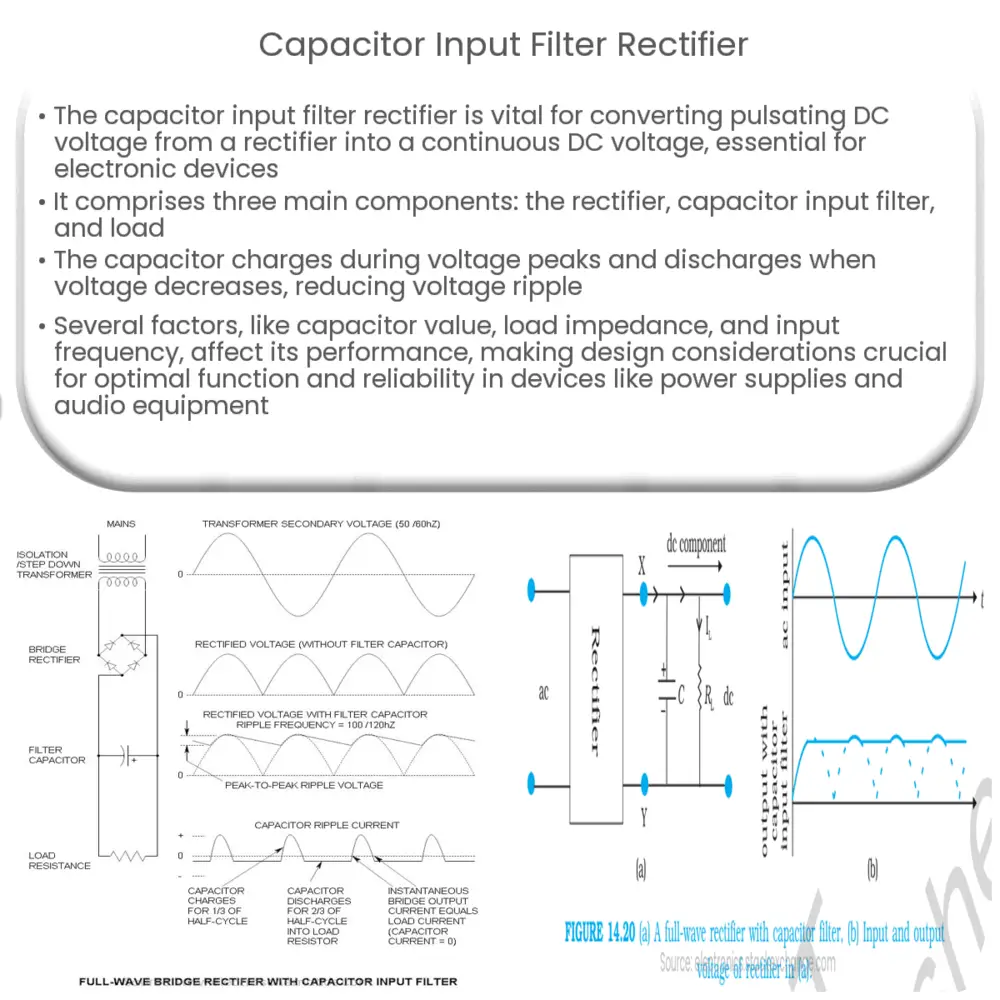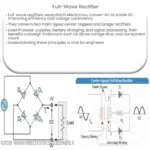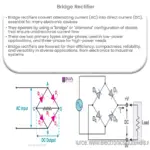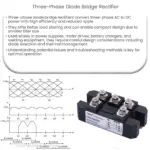A capacitor input filter rectifier converts pulsating DC voltage into a smooth, stable output, essential for powering electronic devices.

Capacitor Input Filter Rectifier: An Introduction
The capacitor input filter rectifier is a crucial component in power supply circuits, especially in devices that require a smooth and stable direct current (DC) voltage. It is responsible for converting the pulsating DC voltage from a rectifier into a stable and continuous DC voltage, which is essential for the proper functioning of electronic devices. In this article, we will discuss the basics of capacitor input filter rectifiers, their working principles, and the factors that influence their performance.
Basic Components of a Capacitor Input Filter Rectifier
A capacitor input filter rectifier circuit typically consists of three main components:
- Rectifier: The rectifier is responsible for converting alternating current (AC) voltage into pulsating DC voltage. It is usually constructed using diodes, which allow current to flow in one direction only. Rectifiers can be single-phase or three-phase, and they can be half-wave or full-wave, depending on the application requirements.
- Capacitor Input Filter: This is the key component that smooths out the pulsating DC voltage from the rectifier. The capacitor stores energy when the voltage increases and releases it when the voltage decreases, effectively reducing voltage ripple and producing a smoother DC output.
- Load: The load represents the device or circuit that utilizes the smooth DC voltage supplied by the capacitor input filter rectifier. The load’s characteristics, such as its impedance, can affect the performance of the filter and must be considered during the design process.
Working Principle of Capacitor Input Filter Rectifier
The operation of a capacitor input filter rectifier can be divided into two main stages: rectification and filtering. During the rectification stage, the rectifier converts the input AC voltage into a pulsating DC voltage. This output still contains significant voltage ripple, which can be detrimental to the operation of sensitive electronic devices. To reduce the ripple, the pulsating DC voltage is passed through the capacitor input filter.
As the pulsating voltage enters the capacitor, it charges the capacitor to the peak voltage of the input waveform. When the input voltage starts to decrease, the capacitor discharges, supplying the load with the stored energy. This process effectively reduces the voltage ripple and provides a smoother DC output to the load.
Factors Influencing Performance
Several factors can influence the performance of a capacitor input filter rectifier, including:
- Capacitor value: A larger capacitor value will result in better filtering performance, as it can store more energy and thus supply the load for a longer duration during the discharge phase. However, larger capacitors also take longer to charge, which can affect the circuit’s transient response.
- Load impedance: A higher load impedance will result in a lower current draw, which reduces the discharge rate of the capacitor and leads to better filtering performance. Conversely, a lower load impedance will demand more current, causing a faster discharge rate and increased voltage ripple.
- Input frequency: The input frequency of the AC voltage affects the rate at which the capacitor charges and discharges. Higher input frequencies lead to shorter charging and discharging periods, which can result in increased voltage ripple if the capacitor value is not appropriately selected.
Design Considerations for Capacitor Input Filter Rectifiers
When designing a capacitor input filter rectifier, several factors must be considered to ensure optimal performance and reliability. These include:
- Selection of Rectifier Type: The choice between half-wave and full-wave rectifiers depends on the application’s requirements. Full-wave rectifiers offer better filtering performance, as they produce a higher frequency output, allowing for smaller capacitor values. However, they may be more complex and costly to implement than half-wave rectifiers.
- Capacitor Voltage Rating: The capacitor’s voltage rating must be higher than the peak voltage of the rectified input to prevent capacitor failure due to overvoltage. A safety margin should also be considered to account for voltage spikes and manufacturing tolerances.
- Capacitor Type: Various capacitor types can be used in input filter applications, such as electrolytic, tantalum, or ceramic capacitors. Each type has its advantages and disadvantages, depending on factors like cost, size, and performance characteristics. It is essential to choose the appropriate capacitor type for the specific application.
- Thermal Management: The rectifier and capacitor components may generate heat during operation, which must be managed to prevent performance degradation or failure. Adequate heat sinking or forced cooling solutions should be considered when designing the circuit.
Applications of Capacitor Input Filter Rectifiers
Capacitor input filter rectifiers are widely used in various electronic devices and systems, including:
- Power Supplies: They are commonly found in linear and switching power supplies, providing stable DC voltage for sensitive electronic circuits.
- Battery Chargers: Capacitor input filter rectifiers are used in battery chargers to ensure a smooth and constant charging current for the battery.
- Audio Equipment: Audio amplifiers and other audio devices require low ripple voltage supplies for optimal performance, making capacitor input filter rectifiers a popular choice for these applications.
- Communication Systems: Radio frequency (RF) communication systems and other communication equipment require clean and stable DC supplies, which can be provided by capacitor input filter rectifiers.
Conclusion
In conclusion, capacitor input filter rectifiers play a crucial role in providing stable and smooth DC voltage for various electronic devices and systems. A thorough understanding of their working principles, performance factors, and design considerations is essential for designing efficient and reliable power supply circuits. By selecting the appropriate rectifier type, capacitor value, and other components, engineers can optimize the performance of capacitor input filter rectifiers and ensure the reliable operation of the devices they power.




